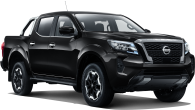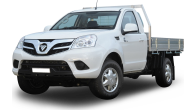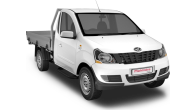Tim Robson puts the Triton GLS dual cab through its paces in the South Australian outback.
The Triton has quietly served Mitsubishi very well for the last almost-40 years. The first-generation car wasn't sold here, but the next three have sold more than 495,000 between them - and 150,000 in the previous MN model alone.
It's held its own in the top three of the 4x4 dual cab market for the last few years, fighting the good fight against the long-reigning Toyota HiLux and the impertinent newcomer, the Ford Ranger.
There is movement on the horizon, though. Both Volkswagen and Nissan are making inroads on the segment, while new players like Renault and Mercedes-Benz lurk on the horizon.
As well, the light truck has had to reinvent itself as a civilian-spec hauler with all the bells and whistles consumers have come to expect from a modern day car - and offer it at just the right price.
Developed with local conditions in mind, we had the opportunity to test the offroad-rated Triton in a less suburban environment than it's usually found in, and grabbed it with both dusty hands.
Mitsubishi Triton 2016: Gls (4X4)
| Engine Type | Diesel Turbo 4, 2.4L |
|---|---|
| Fuel Type | Diesel |
| Fuel Efficiency | 7.2L/100km (combined) |
| Seating | 5 |
| Price From | $18,810 - $23,870 |
| Safety Rating |
|
Is there anything interesting about its design?
8 / 10
While it's not quite true to say that the latest Triton is a 100 per cent new vehicle, it's pretty close. More than 80 per cent of the body and 40 per cent of the chassis is all new, while the other parts – including suspension and steering – have been comprehensively overhauled.
The previous generation Triton was hailed as a ute with attitude in its swoopy, curvy form, and the current MQ carries the trend forward – albeit with more embellishments and refinements.
The latest Triton has implemented a few key changes to its interior packaging that lift it a long way past the previous gen model.
The divide between the tray and the cab, for example, is much less exaggerated, and the grille and headlight treatment has been thoroughly worked over, as have the taillights. And while the physical shape of the Triton's silhouette is largely the same, there are new folds and creases along the flanks to draw in the eye.
It retains its short overhang on the front, while the rear tray is only a couple of millimetres larger than versions that have come before.
How practical is the space inside?
8 / 10
The latest Triton has implemented a few key changes to its interior packaging that lift it a long way past the previous gen model.
Its front seats, for example, are vastly improved, with deeper bases and more supportive backs, and they're comfortable even after a day of being tossed around on a 4x4 track.
The rear space is suitable for larger adults, with seat backs that aren't fixed too upright, and 20mm extra legroom over the previous model.
The steering wheel, too, is now adjustable for both rake and reach, while the multimedia system in the centre console has been updated. It's just a simple touchscreen system in our GLS tester, which offers Bluetooth streaming but no satellite navigation.
The rear space is suitable for larger adults, with seat backs that aren't fixed too upright, and 20mm extra legroom over the previous model.
There's a pair of cupholders up front and slots for bottles in each of the four doors, as well as a deep centre console bin. There are no air vents for the rear seat passengers, though, while hard plastic surfaces at the driver's knee height get annoying if used to brace while off-roading.
Does it represent good value for the price? What features does it come with?
8 / 10
Starting at $40,990 for the GLS 4x4 double cab before on road costs, the Triton carries a pretty heft cost advantage into the battle over the HiLux ($48,490 for the SR), Ranger ($48,090 for the XLS double cab) and Navara ($45,990 for the ST).
A single USB port, adjustable speed limiter and cruise control, a centre diff-equipped Super Select II 4WD system, 17x7.5-inch alloys, HID headlights and LED daytime running lamps, fog lamps, side steps, rear step, sports bar, rearview camera, folding door mirrors, dual-zone air conditioning, a 6.1-inch touchscreen, six speakers and digital radio all come standard.
What are the key stats for the engine and transmission?
7 / 10
All 4x4 Tritons use Mitsubishi's new 4N15 low-compression, MIVEC-equipped 2.4-litre four-cylinder turbo diesel engine under the bonnet.
With a host of new technologies, including a lightweight variable geometry turbo, an all-alloy block and a timing chain to replace the previous Triton's belt arrangement, the engine makes 133kW and 430Nm – 2kW and up to 80Nm more than previously.
The Triton is also surprisingly talented off road, with moderately difficult 4x4 tracks traversed with ease.
A five-speed Aisin automatic has been pinched from the current Pajero, albeit with a different electronic control unit, while a new heavy-duty six-speed manual gearbox makes its debut in the Triton.
The Triton uses the Super Select 4WD II system, which offers four driving modes including a locked 4x4 mode. The GLS, however, misses out on a locking rear diff as standard.
Worth noting; the Triton is the only ute in the category that can be used in AWD mode on sealed roads, as the 4H (for 'high range') mode isolates the centre diff from the driveline.
How much fuel does it consume?
7 / 10
Mitsubishi claims fuel economy figures of between 7.2L/100km (manual) and 7.6L/100km (automatic).
Our day aboard the GLS manual – spent mostly in low-range 4x4 mode – netted a dash-indicated figure of 8.4L/100km.
What's it like to drive?
8 / 10
Our 120km test in a manual GLS dual cab pickup reveals an easy-to-live-with personality, a settled, dynamic ride quality even when unladen, and truly low levels of noise intrusion from either the engine or the tyres on sealed roads.
The Triton is also surprisingly talented off road, with moderately difficult 4x4 tracks traversed with ease. It doesn't get the same level of electronic assistance as the Pajero Sport, so it's still a matter of old-school techniques like gearing and throttle control coming to the fore.
It'll winch its way up or down impressively steep slopes in low-range, though, and it displays stability and comfort on graded gravel roads.
Its tyres, too, are more biased towards tarmac and light gravel rather than full-on mud, which is worth bearing in mind before setting out.
It'll winch its way up or down impressively steep slopes in low-range, though, and it displays stability and comfort on graded gravel roads.
Warranty & Safety Rating
What safety equipment is fitted? What safety rating?
7 / 10
It comes with seven airbags (driver, passenger, knee, side and curtain), brake assist, ESC, hillstart assist and trailer sway control (when connected to a trailer with electric brakes) as standard, and is now rated at a maximum of five ANCAP stars.
What does it cost to own? What warranty is offered?
8 / 10
Mitsubishi offers a three-year, unlimted kilometre warranty on the Triton, and also has a capped price service plan in place for the car, which covers the first four years of service.
The first service at 15,000km or 12 months is $350, with the 30,000, 45,000 and 60,000km services jumping to $580 apiece. The services exclude ‘wear and tear' items as well as fluids.
Verdict
Dimensionally speaking, the Triton is physically the smallest of the current crop of 4x4 style-side pickups, and it shows in the car's relative agility on the road. Its impressively quiet interior and calm ride also play in its favour as well.
It's also got the chops to fulfill its original premise of getting off the beaten track and heading bush. It's not as sophisticated as its twin, the Pajero Sport wagon, but it's still capable of tackling moderately hard bush tracks in standard guise.
Swap the tyres to something more rugged and add a few accessories, and the Triton will become even more capable out bush.
Would a Triton be your off road ute of choice, or would you prefer a Ranger or HiLux? Tell us what you think in the comments below.
Click here to see more 2016 Mitsubishi Triton GLS dual-cab pricing and spec info.
Pricing Guides

Range and Specs
| Vehicle | Specs | Price* |
|---|---|---|
| Exceed (4x4) | 2.4L, Diesel, 5 SPEED AUTOMATIC | $20,460 - $25,960 |
| Gls (4X4) | 2.4L, Diesel, 5 SPEED AUTOMATIC | $18,810 - $23,760 |
| Glx | 2.4L, Diesel, 5 SPEED AUTOMATIC | $13,750 - $18,040 |






.jpg)
.jpg)
.jpg)
.jpg)
.jpg)
.jpg)
.jpg)
.jpg)
.jpg)
.jpg)
.jpg)
.jpg)

.jpg)








.jpg)




.jpg)